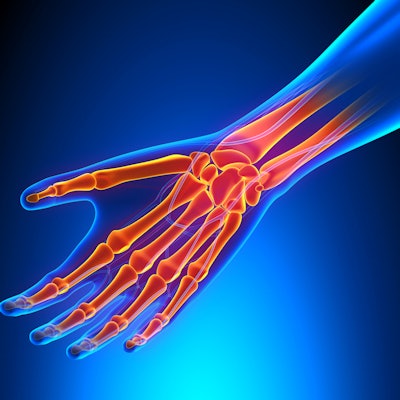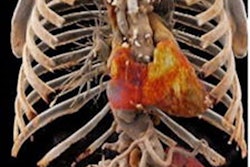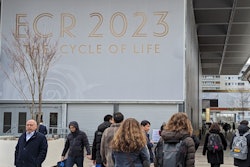
Photon-counting CT (PCCT) improves the quality of wrist imaging with a radiation dose reduction of 50% compared to conventional CT, according to a study published in the 1 February issue of the European Journal of Radiology.
Ronald Booij, PhD, a postdoctoral researcher and photon-counting CT/CT expert radiographer at Erasmus Medical Center in Rotterdam, the Netherlands, and colleagues found that PCCT boosted the sharpness of the wrist images -- although the technology did have lower contrast-to-noise ratio and increased noise in general.
"Despite a lower contrast-to-noise ratio and increased noise, the trabecular and cortical sharpness were twofold higher with [PCCT]," the authors noted.
CT is often used to evaluate fine bone structures and particularly to assess bone trauma. Ultrahigh-resolution CT may be used for this purpose, as well as high-resolution imaging with multidetector CT, but both techniques require high radiation doses. PCCT's ability to directly convert x-ray photons into electronic signals -- in contrast to conventional CT's two-step process of converting x-rays to light and then to an electronic signal -- translates to high spatial resolution and low radiation doses, they explained.
"In recent studies, [PCCT] has been shown to result in higher sharpness, improved delineation of fine bone structures and superior image quality than [conventional] CT," Booij and colleagues stated. "However, a detailed assessment of improvements in image quality and the ability to reduce radiation dose in imaging of the wrist using [PCCT] remains limited."
Study logistics
To address this knowledge gap, the Erasmus team conducted a study that included four human cadaver wrist specimens that were scanned with both conventional CT imaging and PCCT.
The radiation dose for the conventional exams was 12.2 mGy and 6.1 mGy for the PCCT studies. The images were reconstructed using the thinnest allowable slice thickness: 0.4 mm for conventional CT and 0.2 mm for PCCT. Six radiologist readers assessed each type of exam for trabecular architecture, cortical bone, and general image quality.
The researchers found that the contrast-to-noise ratio on PCCT exams at an equal dose to conventional CT studies was 39% lower and 59% lower compared to conventional CT at PCCT half dose.
It also found the following:
- Mean contrast-to-noise ratio values were 15.8 Hounsfield units on PCCT imaging and 25.7 Hounsfield units on conventional CT imaging.
- At an equal dose, the contrast-to-noise ratio was 39% lower on PCCT imaging compared to conventional CT imaging.
- Trabecular sharpness with PCCT imaging was 71% and 66% higher at normal and half doses compared to conventional CT imaging.
- Cortical edge sharpness was 42% and 45% higher at normal and half PCCT doses compared to conventional CT imaging.
The authors did find that noise levels on PCCT exams were higher than those on conventional CT: 120% higher at an equal dose and 252% higher on a half dose. But this finding isn't a deal breaker, they pointed out.
"Despite an increase in noise ... [PCCT] offers superior visibility of bone structures in the wrist even at half dose compared to [conventional] CT at normal dose," they wrote. "These results are relevant for several pathologies, especially the detection, characterization and follow-up of fractures, but also other pathologies such as degenerative and inflammatory disease."
The researchers acknowledged that the study sample was small, and since the specimens were taken from cadavers, it was obviously impossible to assess wrist motion. But the findings confirm that PCCT imaging shows promise for musculoskeletal indications.
"[PCCT] allows for a twofold higher visibility of bone structure sharpness and an overall improved image quality of the wrist compared to images obtained from [conventional CT]," they concluded.



















